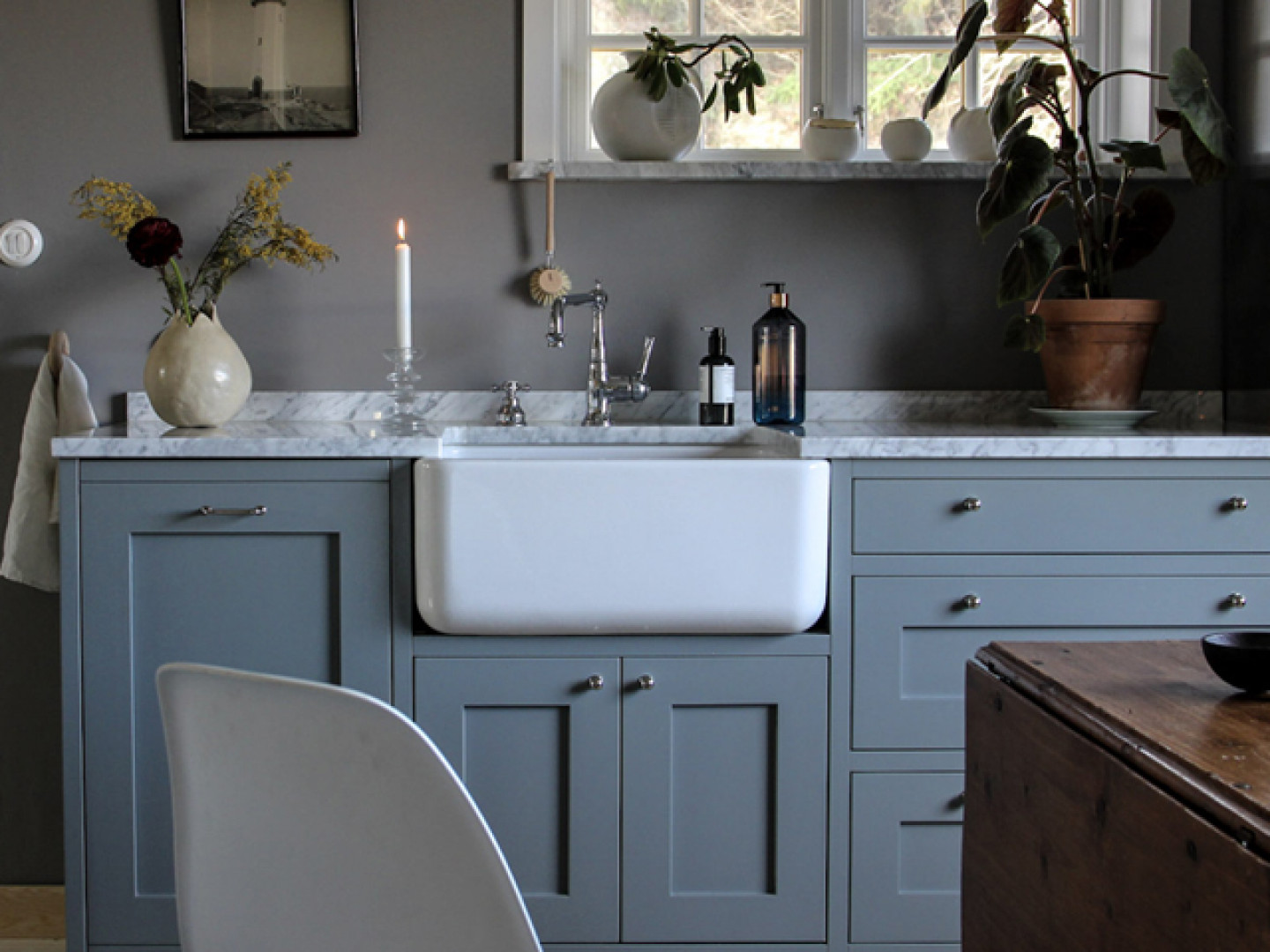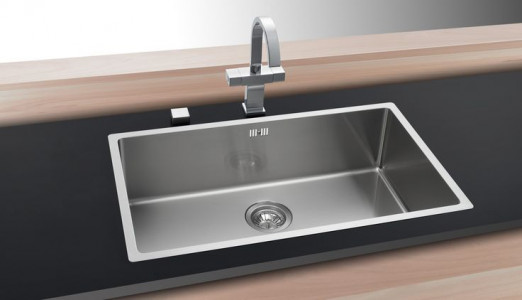Everything but the kitchen sink
Data collected by Statistica reveals that as of 2016, 45% of all UK households own a dishwasher; a significant increase from just 18% when the survey began in 1994. However, the proliferation of the dishwasher hasn’t rendered the kitchen sink obsolete—the sink remains the heart of the kitchen and choosing the right one for your lifestyle is a crucial element of any kitchen design project.
But how do you go about choosing a sink when there are so many options on the market today?
{{insert_content_snippet}}
French farmhouse sinks

The French farmhouse sink is similar to both the Belfast and Butler sinks, except unlike its UK counterparts, the clay used in production is far more refined, resulting in thinner walls and a more delicate design. Although the French farmhouse style is structurally less robust than the Butler or the Belfast, the style has been manufactured since the 17th century and as a result, the expert production methods make it a strong and durable option.
French farmhouse sinks are considered a mark of luxury; often selected for their aesthetic qualities, they are more ornate and elegant than the rustic Belfast or Butler sinks.
Notable manufacturers include French heritage brand Chambord, whose sinks range from traditional ceramic to contemporary stainless steel. As a brand, Chambord offers a diverse range of styles and finishes, including a variety of unique materials and colours, including sinks with aprons in leather, stainless steel, copper and even travertine; a tan coloured, marbled Italian limestone.

The Blue de Sevres sink is a particularly luxurious French farmhouse sink, which combines classic French design with a contemporary edge; the rich mottled blue glaze inspires associations with the art of antiquity, while the patterned varieties add character to any kitchen.
There is a level of prestige associated with the farmhouse style sink; Shaws of Darwen have been handcrafting their farmhouse sinks since 1897, and each one carries an impression on its base of the craftsperson who created it along with a Certificate of Authenticity to ensure provenance and a lifetime of quality service to you and your kitchen.
While ceramic sinks tend to be a more expensive option than stainless steel, there is no compromise on durability, longevity and timeless design. Farmhouse sinks are available as both double and single bowl, so whichever sink style you eventually decide to invest in, you can be certain that if you choose a Butler, Belfast or French farmhouse sink you are investing in a product which has proven its worth for generations.
Butler and Belfast sink
 Butler sink in situ, image courtesy of Shaws of Darwen.
Butler sink in situ, image courtesy of Shaws of Darwen.
Perhaps considered one of the most popular farmhouse sink varieties, the Butler sink’s origins are steeped in British domestic history. Traditionally, a butler would have his own sink in the pantry in which to clean his uniform and to distinguish him from the other servants. Designed during a time when running water was uncommon in most households, these thick-walled, fireclay sinks were designed to hold large amounts of water gathered from local wells and rivers, meaning that Butler sinks are both deep and wide – perfect for a busy country kitchen.
 Belfast sink in situ, image courtesy of Shaws of Darwen.
Belfast sink in situ, image courtesy of Shaws of Darwen.
The Belfast sink hails, unsurprisingly, from Belfast in Northern Ireland. It is similar in style to the Butler but while the Butler, and varieties of French farmhouse sink lack a weir overflow, given the greater rate of precipitation in Ireland, the Belfast sink does feature a weir overflow, enabling water to drain out quickly.
The Franke sink
 Ascona ASX 611-100 Stainless Steel in situ, image courtesy of Franke.
Ascona ASX 611-100 Stainless Steel in situ, image courtesy of Franke.
Franke is a Swiss manufacturer producing easy to install inset sinks in a variety of materials and styles. Stainless steel is a popular choice for the Franke range and is perfect for busy kitchens given that it is easy to keep clean, doesn’t scratch or crack easily and can withstand extreme temperatures.
Franke offers ceramic, fireclay and granite options for those seeking a more traditional farmhouse design, while those in search of a more modern alternative can opt for sinks made from materials including granite, tectonite and fragranite, which can withstand heat and prevent bacterial growth.
 Compact Plus CPX P 652 Stainless Steel, image courtesy of Franke.
Compact Plus CPX P 652 Stainless Steel, image courtesy of Franke.
Franke sinks are highly customisable, available in an assortment of colours, even offering a black ceramic option for more daring interior design projects. They can be fitted with a variety of taps, faucets and add-ons such as waste disposal baskets. Similarly, they offer a selection of traditional farmhouse sinks in a variety of styles, depths and bowl options, for example, the traditional Franke Belfast VBK720 Ceramic kitchen sink, the simple Ascona ASX 611-100 sink, to the more dynamic Compact Plus CPX P 652.
Franke’s dedication to price and variety positions the brand as an industry leader in sink manufacturing will be sure to bring a unique style to the kitchen.
Composite Sink
 Lamona Black Granite Composite 1.5 Bowl Sink, image courtesy of Howdens.
Lamona Black Granite Composite 1.5 Bowl Sink, image courtesy of Howdens.
Made of roughly 80% compressed quartz dust, or fine granite sand and bonded with 20% acrylic resin, the composite sink is similar in style and behaviour to granite or stone but the mix of materials results in a cost-effective, durable and easy to maintain product.
Composite sinks have a grainy texture and flecked appearance, much like granite proper, but their compositional nature means that is easier to customize with bespoke pigments.
Manufacturers include Blanco, Astracast, Wickes and Howdens Joinery.
Howdens Joinery is the largest manufacturer of fitted kitchens in the UK. The Lamona Sink is a favourite of ours thanks to its simple, modern design and interchangeable materials.
Stainless steel sinks
 Lamona single bowl stainless steel sink in situ, image courtesy of Howdens.
Lamona single bowl stainless steel sink in situ, image courtesy of Howdens.
Research conducted by Franke revealed that 70% of today’s sink customers opt for stainless steel as it is an inexpensive, versatile material that can be adapted to a range of sink shapes and styles such as undermount, top mount and the more traditional farmhouse, Butler and Belfast styles.
Stainless steel is classified in terms of gauge. Lower gauge steel is heavier; higher gauge is lighter. Most sinks fall between 15 to 24 gauge range and residential sinks are usually between 18 and 22, with an average thickness between 11mm and 8mm.
Although highly durable, stainless steel sinks can be noisy and most will be treated or padded to reduce this. Similarly, unlike ceramic alternatives, stainless steel sinks show water spots so are more commonly chosen for functionality over aesthetics.
The Undermount sink
 Undermounted stainless steel sink in situ, image courtesy of Roundhouse Design.
Undermounted stainless steel sink in situ, image courtesy of Roundhouse Design.
The lip is secured underneath the solid countertop allowing for more space around the sink, the edge of which appears to drop off into the sink basin, allowing for easy cleaning as there is no rim to collect dirt.
Installation of these sinks can be challenging. It is advised that they are fitted by a professional and be fitted with solid surface countertops. The minimal, clean and space saving design, however, is well worth the effort.
Roundhouse Design are masters when it comes to the undermount sink. The standard in which they execute kitchen design is exceptional, and we love the undermount sink found in Ottolenghi’s personal kitchen, installed by Roundhouse. Whether you are after a marble, ceramic or stainless-steel finish, they are sure to cater to your undermount needs.
The round sink
 4307 "Saone" Round Bowl, image courtesy of Herbeau.
4307 "Saone" Round Bowl, image courtesy of Herbeau.
A less popular choice than the previously mentioned sinks, however, if you have a smaller kitchen, the round sink is a great choice as it saves space. With the choice of inset or undermount installation, this sink is also a versatile choice.
In addition, round sinks make the perfect second sink for prepping food.
Herbeau are renowned for their craftsmanship. To this manufacturer, tradition is art, and this can be seen in their stunning copper, stainless steel and ceramic sinks.
Their Saone round bowl sink as the drum shape is compact but maximises space.
According to consumer reports, it is most important to focus on the material (over manufacturer) when choosing a sink to suit your specific needs but with such a wide range of traditional and innovative materials now on the market, a trusted manufacturer will be able to advise the best sink and material for you.
Consider the size and depth carefully; bowls vary between 152mm and 305mm in depth and the deeper the bowl the less backsplash it will generate. Also consider your own height when choosing a style of sink, as deeper sinks, such as the French farmhouse, Belfast, Butler and undermounted sinks may be uncomfortable for those of a shorter stature.
Regardless of what style, material or manufacturer you opt for, remember to consider the lifecycle of your sink when making your final decision; carefully consider both installation and repairs. Most sinks on the market will come with a lifetime warranty, further demonstrating the dedication to quality and the craftsmanship of sink-makers, but while manufacturers will usually supply replacement parts it is often up to the customer to undertake any repairs.

